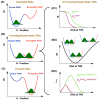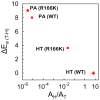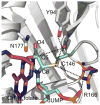Activation of Two Sequential H-transfers in the Thymidylate Synthase Catalyzed Reaction
- PMID: 26576323
- PMCID: PMC4643671
- DOI: 10.1021/acscatal.5b01332
Activation of Two Sequential H-transfers in the Thymidylate Synthase Catalyzed Reaction
Abstract
Thymidylate synthase (TSase) catalyzes the de novo biosynthesis of thymidylate, a precursor for DNA, and is thus an important target for chemotherapeutics and antibiotics. Two sequential C-H bond cleavages catalyzed by TSase are of particular interest: a reversible proton abstraction from the 2'-deoxy-uridylate substrate, followed by an irreversible hydride transfer forming the thymidylate product. QM/MM calculations of the former predicted a mechanism where the abstraction of the proton leads to formation of a novel nucleotide-folate intermediate that is not covalently bound to the enzyme (Wang, Z.; Ferrer, S.; Moliner, V.; Kohen, A. Biochemistry2013, 52, 2348-2358). Existence of such intermediate would hold promise as a target for a new class of drugs. Calculations of the subsequent hydride transfer predicted a concerted H-transfer and elimination of the enzymatic cysteine (Kanaan, N.; Ferrer, S.; Marti, S.; Garcia-Viloca, M.; Kohen, A.; Moliner, V. J. Am. Chem. Soc.2011, 133, 6692-6702). A key to both C-H activations is a highly conserved arginine (R166) that stabilizes the transition state of both H-transfers. Here we test these predictions by studying the R166 to lysine mutant of E. coli TSase (R166K) using intrinsic kinetic isotope effects (KIEs) and their temperature dependence to assess effects of the mutation on both chemical steps. The findings confirmed the predictions made by the QM/MM calculations, implicate R166 as an integral component of both reaction coordinates, and thus provide critical support to the nucleotide-folate intermediate as a new target for rational drug design.
Keywords: C-H bond activation; Donor and acceptor distances; Kinetic Isotope Effect; Phenomenological models; QM/MM calculations; Thymidylate Synthase; Tunneling ready state.
Figures







Similar articles
-
Experimental and Computational Studies Delineate the Role of Asparagine 177 in Hydride Transfer for E. coli Thymidylate Synthase.ACS Catal. 2018 Nov 2;8(11):10241-10253. doi: 10.1021/acscatal.8b02554. Epub 2018 Sep 20. ACS Catal. 2018. PMID: 31275729 Free PMC article.
-
Thymidylate synthase catalyzed H-transfers: two chapters in one tale.J Am Chem Soc. 2010 Jul 21;132(28):9820-5. doi: 10.1021/ja103010b. J Am Chem Soc. 2010. PMID: 20575541 Free PMC article.
-
QM/MM calculations suggest a novel intermediate following the proton abstraction catalyzed by thymidylate synthase.Biochemistry. 2013 Apr 2;52(13):2348-58. doi: 10.1021/bi400267q. Epub 2013 Mar 22. Biochemistry. 2013. PMID: 23464672 Free PMC article.
-
Kinetic isotope effects as a probe of hydrogen transfers to and from common enzymatic cofactors.Arch Biochem Biophys. 2014 Feb 15;544:96-104. doi: 10.1016/j.abb.2013.10.010. Epub 2013 Oct 22. Arch Biochem Biophys. 2014. PMID: 24161942 Free PMC article. Review.
-
The importance of ensemble averaging in enzyme kinetics.Acc Chem Res. 2015 Feb 17;48(2):431-8. doi: 10.1021/ar500319e. Epub 2014 Dec 24. Acc Chem Res. 2015. PMID: 25539028 Free PMC article. Review.
Cited by
-
Bacterial versus human thymidylate synthase: Kinetics and functionality.PLoS One. 2018 May 1;13(5):e0196506. doi: 10.1371/journal.pone.0196506. eCollection 2018. PLoS One. 2018. PMID: 29715278 Free PMC article.
-
Noncovalent Intermediate of Thymidylate Synthase: Fact or Fiction?J Am Chem Soc. 2016 Jul 6;138(26):8056-9. doi: 10.1021/jacs.6b03826. Epub 2016 Jun 24. J Am Chem Soc. 2016. PMID: 27327197 Free PMC article.
-
Targeting Methyltransferases in Human Pathogenic Bacteria: Insights into Thymidylate Synthase (TS) and Flavin-Dependent TS (FDTS).Molecules. 2019 Apr 25;24(8):1638. doi: 10.3390/molecules24081638. Molecules. 2019. PMID: 31027295 Free PMC article. Review.
-
Experimental and Computational Studies Delineate the Role of Asparagine 177 in Hydride Transfer for E. coli Thymidylate Synthase.ACS Catal. 2018 Nov 2;8(11):10241-10253. doi: 10.1021/acscatal.8b02554. Epub 2018 Sep 20. ACS Catal. 2018. PMID: 31275729 Free PMC article.
-
Examinations of the Chemical Step in Enzyme Catalysis.Methods Enzymol. 2016;577:287-318. doi: 10.1016/bs.mie.2016.05.017. Epub 2016 Jun 28. Methods Enzymol. 2016. PMID: 27498642 Free PMC article.
References
-
- Carosati E, Tochowicz A, Marverti G, Guaitoli G, Benedetti P, Ferrari S, Stroud RM, Finer-Moore J, Luciani R, Farina D, Cruciani G, Costi MP. J Med Chem. 2012;55:10272–10276. - PubMed
-
- Sergeeva OA, Khambatta HG, Cathers BE, Sergeeva MV. Biochem Biophys Res Commun. 2003;307:297–300. - PubMed
-
- Costi MP, Tondi D, Rinaldi M, Barlocco D, Pecorari P, Soragni F, Venturelli A, Stroud RM. Biochim Biophys Acta, Mol Basis Dis. 2002;1587:206–214. - PubMed
-
- Popat S, Matakidou A, Houlston RS. J Clin Oncol. 2004;22:529–536. - PubMed
-
- Salonga D, Danenberg KD, Johnson M, Metzger R, Groshen S, Tsao-Wei DD, Lenz HJ, Leichman CG, Leichman L, Diasio RB, Danenberg PV. Clin Cancer Res. 2000;6:1322–1327. - PubMed
Grants and funding
LinkOut - more resources
Full Text Sources
Other Literature Sources
